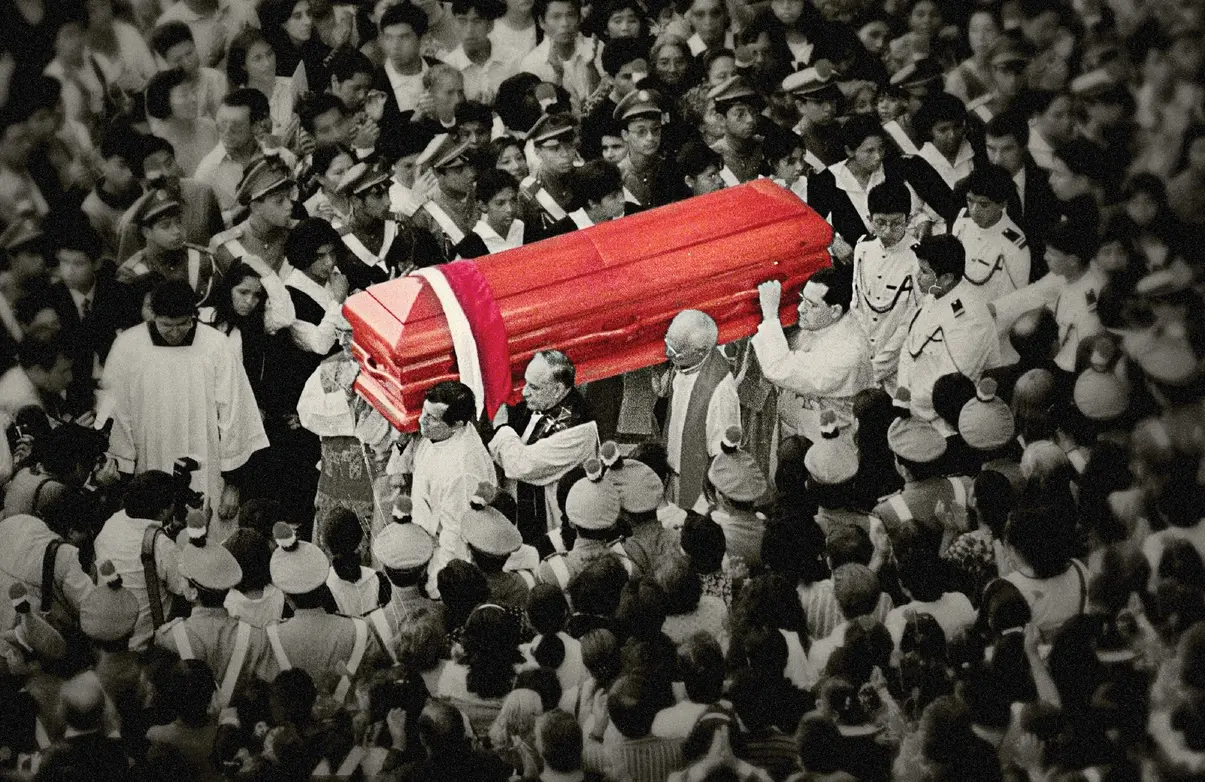The Art Of Political Murder May Feel Like Homework. Watch It Anyway.
-
 Mourners escort the coffin of the assassinated Bishop Juan Gerardi in The Art Of Political Murder. (HBO)
Mourners escort the coffin of the assassinated Bishop Juan Gerardi in The Art Of Political Murder. (HBO)The editor-in-chief of the daily newsletter Best Evidence, Sarah D. Bunting knows a thing or two about true crime. Her weekly column here on Primetimer is dedicated to all things true crime TV.
The Art Of Political Murder is a tough sell, but I'll do my best. I do wonder if HBO might have been better off holding this fairly difficult film until after the holiday season, one that's closing out an extraordinarily difficult year. I also wonder if the pointed billing of George Clooney as an executive producer isn't a spoonful of sugar intended to help the medicine of the film go down. I don't doubt the sincerity of Clooney's involvement, but The Art Of Political Murder is one heavy film.
And it's heavy immediately. The first five minutes feature 1) chyrons that let viewers know the film covers a topic most HBO subscribers aren't likely to know much about, the civil war in Guatemala that spanned more than a quarter century and saw two hundred thousand civilians killed; 2) the titular brutal murder of a beloved bishop, Juan Gerardi, who presided over a Catholic Church investigation into the atrocities of the war and was killed just two days after announcing the completion of a commission report, the Recovery of Historical Memory Project (REMHI); 2b) footage of the crime scene, which is remarkably bloody even within the true-crime genre; and 3) the subtitled interviews and context that make up a good 75 percent of the film. This is without mentioning the defiantly evident involvement of those implicated by the report, or the weeping of colleagues remembering that terrifying time 22 years later. Still to come: bigoted rumors started by politicians and journalists about Gerardi's possible involvement in a lethal love triangle; and strongmen threatening commission investigator Ronalth Ochaeta by putting a gun in the mouth of Ochaeta's four-year-old son. There is nothing cheery in the early going; there are no compelling kooks like in Netflix's Tiger King or HBO's own recent Mystery of DB Cooper to leaven the proceedings. The Art Of Political Murder is harsh, and its scary.
But that's the film doing its job, and Art is well made. Directed by Paul Taylor, who usually wears the producer's hat — he was behind the scenes on 2012's The Interrupters, among others — Art is based on a book of the same name by Francisco Goldman. Goldman appears on-camera along with a number of key figures in the case, like Ochaeta, the director of the commission; human-rights activist Helen Mack; Jack Palladino, an investigator brought in from the States; the prosecutor who took several of the conspirators to trial; and Rubén Chenax, introduced as a homeless man who had key eyewitness testimony — but with a key twist. That twist is revealed at just the right time, and until it occurs, Taylor uses excellent access and understated editing to expertly build a sense of hopeless dread, the feeling that the real killers will never be brought to justice, that it was too dangerous even to try, and that the killers knew this and its why they acted with impunity. Often a case figure appears in old footage before being introduced for a talking-head interview in the present day, and more than once, my notes read, "Phew, on camera/still alive"... just to give you a sense of how bleak the prospects seemed for a just result in Gerardi's assassination.
The parallels to the current situation in our own country don't help to improve the mood. The incompetence of the initial government investigation is easy to mock, until you realize that ineptitude is often just an ink cloud that hides corruption. The war crimes exposed in Gerardi's report involved the senseless, needlessly cruel deaths of civilians — people, many of them Maya, who weren't in a position of power that could protect them from a remorseless autocratic government. Ongoing fraud, blithe bigotry, a refusal to accept facts or enact fairness. Art's title is an ironic nod to the fact that tyrannical power doesn't require artfulness at all; it just bludgeons into whatever shape it wants.
Until it can't. Until a judge whose house got firebombed shows up for court the next day, rattled but determined. Until a defendant tries to intimidate Chenax, and fails so utterly that Chenax is smothering a yawn in court. Another compelling aspect of Art is that it illustrates without over-explaining the procedural differences between American trials and Guatemalan ones... although I would have liked a little more on the Guatalalen system writ large and the larger and differing role of the Church in politics and community there. Still, that this doc has me interested in learning more about such things says something in and of itself.
The Art Of Political Murder isn't an easy sit, but that's not what this kind of film is for. It's a doc I'm glad to have watched, and there is hope in this story; maybe that's why HBO didn't hold it until January. You can certainly record it now and watch it after gingerbread season ends, but regardless of the timing, I recommend it.
The Art Of Political Murder premieres on HBO December 16th at 9:00 PM ET.
Sarah D. Bunting co-founded Television Without Pity, and her work has appeared in Glamour and New York, and on MSNBC, NPR's Monkey See blog, MLB.com, and Yahoo!. Find her at her true-crime newsletter, Best Evidence, and on TV podcasts Extra Hot Great and Again With This.
TOPICS: The Art of Political Murder, HBO, George Clooney, True Crime